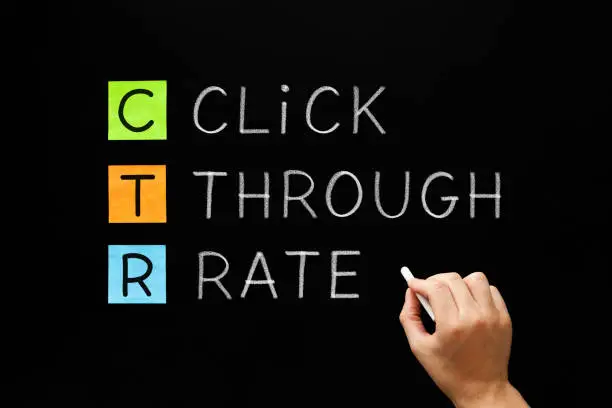
Game-Changing Tactics to Triple Your Click-Through Rates Instantly
Understanding what CTR (Click-Through Rate) is and recognizing its significance in conversion optimization are fundamental steps to enhance your digital marketing strategy.
In the rapidly evolving landscape of digital marketing, where every click matters, CTR emerges as a pivotal metric that gauges the effectiveness of your marketing efforts in engaging users and driving traffic to your website.
Definition of CTR and Its Significance in Digital Marketing
CTR is a metric used in online advertising and digital marketing that calculates the ratio of clicks a particular ad or link receives to the number of times it was shown or displayed (impressions). Mathematically, it is expressed as:
CTR=(Number of Impressions/Number of Clicks) x100
Significance
#1. User Engagement Assessment: CTR provides insights into how effectively your content or advertisement engages the target audience. A higher CTR generally indicates that your content resonates well with the audience and encourages them to take action.
#2. Effectiveness of Ad Copy and Design: CTR helps evaluate the performance of your ad copy, imagery, and overall design. A low CTR may indicate that your content is not appealing or relevant to the audience, prompting the need for adjustments to improve performance.
#3. Cost-Efficiency: CTR impacts your advertising costs, especially in pay-per-click (PPC) campaigns. A higher CTR can lead to lower costs per click (CPC) since platforms often reward ads that perform well with lower advertising costs.
Role of CTR in Measuring Campaign Success
#1. Campaign Performance Evaluation: CTR is a vital metric to evaluate the success of your advertising campaigns. A high CTR signifies that your campaign is resonating well with the audience and driving traffic to your website.
#2. Optimizing Campaigns in Real-Time: By monitoring CTR during an advertising campaign, you can make real-time adjustments to optimize your ads for better performance. For instance, you can tweak ad content, images, or targeting parameters to enhance CTR and overall campaign effectiveness.
#3. Conversion Rate Correlation: While CTR directly measures clicks, it indirectly impacts conversions. A high CTR often indicates that your campaign is effectively driving traffic, increasing the likelihood of conversions such as purchases, sign-ups, or inquiries.
Understanding Your Audience

Understanding your audience and customizing your marketing campaigns to align with their preferences, behaviors, and demographics is of paramount importance. This approach allows you to create content that deeply connects with them and effectively communicates your message.
#1. Conduct Market Research to Understand Audience Needs
Market research involves a systematic study of the market, including your potential customers, competitors, and industry trends. By conducting market research, you gain insights into the specific needs, desires, challenges, and preferences of your target audience.
a. Identify Audience Segments: Segment your audience based on various factors such as age, gender, location, interests, purchasing behavior, and preferences. This segmentation helps in tailoring your campaigns more precisely.
b. Analyze Competitor Strategies: Understanding how your competitors engage with a similar audience can provide valuable insights. Analyze what tactics work for them and how you can differentiate your approach.
c. Gather Feedback: Collect feedback from current customers through surveys, interviews, or social media interactions. Understanding their experiences and opinions helps in improving your products or services to better meet their expectations.
#2. Utilize Customer Personas to Create Targeted Content
Customer personas are fictional, generalized representations of your ideal customers. They are created based on data and research to embody the key characteristics and behaviors of various segments of your target audience.
a. Persona Development: Create detailed customer personas by amalgamating information gathered from market research. These personas should include demographic details, motivations, challenges, buying behavior, and preferred communication channels.
b. Tailor Content to Personas: Craft content that specifically caters to the needs and preferences of each persona. For example, if one persona values informative blog posts, tailor content accordingly. If another person prefers video content, align your strategy to accommodate this preference.
c. Personalize Communication: Use the insights from customer personas to personalize your communication with each segment of your audience. Personalization enhances engagement and makes your audience feel understood and valued.
By incorporating these steps into your digital marketing strategy, you ensure that your campaigns are not only well-designed but also resonate with your audience effectively. This targeted approach results in higher engagement, better brand perception, and increased chances of conversion.
Crafting Compelling CTAs (Call to Actions)
Creating compelling CTAs (Call to Actions) is a critical aspect of driving conversions in any marketing strategy. A well-crafted CTA serves as a gateway to engage users, guiding them towards desired actions on your platform.
#1. Design CTAs with Clear, Persuasive Language
CTAs should be designed using language that is both clear and persuasive, compelling users to take the desired action. Here are key elements to consider:
a. Be Direct and Action-Oriented: Use verbs that encourage action, such as "Buy Now," "Subscribe Today," or "Download Your Free Ebook." Make it clear what action you want the user to take.
b. Highlight Benefits: Communicate the value or benefit the user will gain by clicking the CTA. For example, "Unlock Exclusive Discounts" or "Get Instant Access."
c. Create a Sense of Urgency: Incorporate language that imparts urgency, like "Limited Time Offer" or "Act Now." This instills a fear of missing out, motivating quicker action.
d. Use First Person Language: Phrasing CTAs in the first person can create a more personal connection, for instance, "Start My Journey" or "Send Me Updates."
#2. Experiment with Different CTA Placements and Styles
The placement and style of your CTAs significantly impact their effectiveness. It's essential to experiment and optimize these aspects for maximum engagement:
a. Above the Fold: Place CTAs prominently near the top of your webpage, ensuring they are visible without scrolling. This immediate visibility can increase the chances of user interaction.
b. Inline CTAs: Embed CTAs within your content where it is relevant. For instance, if discussing a product's features, a CTA saying "Learn More" can be seamlessly integrated.
c. Exit-Intent Pop-ups: Use pop-up CTAs that appear when a user is about to leave your website. These can offer discounts, free trials, or other incentives to entice them to stay or complete a desired action.
d. A/B Testing: Conduct A/B tests to evaluate different styles, colors, sizes, and wording of your CTAs. Analyze the data to understand what resonates best with your audience and fine-tune your approach accordingly.
e. Mobile Optimization: Ensure that CTAs are designed to be mobile-friendly. Consider the smaller screen size and design CTAs that are easily clickable and clearly visible on mobile devices.
By implementing these strategies in crafting your CTAs, you enhance the likelihood of engaging users and driving them towards the desired actions, ultimately leading to increased conversions and improved overall success of your marketing efforts.
Optimizing Website Speed and Performance

Optimizing your website's speed and performance is pivotal to ensuring a positive user experience. A slow website can deter users and hamper engagement, conversions, and overall satisfaction. Here are key strategies to improve your website's speed and performance:
#1. Minimize Page Loading Time through Optimized Images and Code
a. Image Optimization:
i. Compress images to reduce file size without compromising quality. Use formats like JPEG or PNG and employ image compression tools to achieve the right balance between image quality and loading speed.
ii. Specify image dimensions to prevent unnecessary reflows and layout shifts, which can significantly impact load times.
b. Code Optimization:
i. Minimize and streamline your HTML, CSS, and JavaScript code. Remove unnecessary spaces, comments, and redundant code to reduce file sizes.
ii. Combine multiple CSS or JavaScript files into one to reduce the number of requests made by the browser, enhancing load speed.
iii. Leverage browser caching to store frequently accessed resources locally, reducing the need for repeated downloads.
c. Load Critical Resources First:
Prioritize loading critical resources, like above-the-fold content and essential scripts, before other non-essential elements. This technique, known as "critical path rendering," improves perceived page speed.
#2. Ensure Mobile Responsiveness for All Devices
a. Responsive Design:
Utilize responsive web design principles to ensure your website functions seamlessly across various devices and screen sizes. This guarantees a consistent and user-friendly experience regardless of the device being used.
b. Mobile-First Approach:
Design and develop your website with a mobile-first approach, optimizing for mobile devices before scaling up to larger screens. This methodology helps in creating a more efficient and faster mobile experience.
c. Touch-Friendly Interface:
Optimize the layout and design for touch interactions, ensuring buttons and interactive elements are appropriately sized and spaced for easy navigation on mobile devices.
d. Accelerated Mobile Pages (AMP):
Consider implementing AMP, a Google-backed framework that creates fast-loading, mobile-optimized web pages. AMP pages are designed for rapid load times and improved mobile user experience.
A/B Testing and Data Analysis
A/B testing, also known as split testing, is a fundamental technique in digital marketing that involves comparing two versions (A and B) of a webpage or marketing element to determine which performs better. It allows for informed decisions based on real data, ultimately leading to the optimization and improvement of marketing strategies.
#1. Test Different Headlines, Visuals, and CTAs to Identify High-Performing Variations:
a. Headlines:
i. Experiment with varying headline styles, lengths, and tones to gauge which grabs the audience's attention and encourages them to continue engaging with your content or click through.
iii. Test questions, statements, or offers to determine what resonates best with your target audience.
b. Visuals:
i. Test different images, graphics, or videos to see which visual elements are most appealing and effectively convey your message or product.
ii. Evaluate the impact of color schemes, fonts, and overall design on user engagement and conversion rates.
c. CTAs (Call to Actions):
i. Test different CTA text, colors, shapes, and placements to find the combinations that prompt the most clicks and conversions.
ii. Experiment with action-oriented language, urgency-inducing phrases, and various CTA sizes to optimize their effectiveness.
#2. Use Analytics to Make Data-Driven Decisions and Improvements:
a. Collect Data:
Utilize web analytics tools like Google Analytics to gather data on user behavior, engagement, traffic sources, and conversion rates. This data provides insights into how users interact with your website and campaigns.
b. Analyze Results:
Analyze the results of A/B tests and other marketing initiatives. Compare metrics such as click-through rates, conversion rates, bounce rates, and time spent on page to identify trends and patterns.
c. Identify Successful Strategies:
Determine which variations or strategies yield the best results based on the data analysis. These successful strategies can guide future campaign optimization efforts.
d. Iterate and Optimize:
Use the insights gained from data analysis to make informed adjustments to your marketing campaigns. Continuously iterate on your strategies to improve performance based on the data-driven decisions.
A/B testing combined with thorough data analysis empowers marketers to make informed decisions, refine their campaigns, and enhance overall performance. By systematically testing and optimizing various elements and leveraging data insights, you can maximize the impact of your digital marketing efforts and achieve better engagement and conversion rates.
Leveraging Social Proof
Utilizing social proof, which includes elements like customer reviews, testimonials, and case studies, is a powerful strategy to instill trust and credibility in potential customers. Social proof acts as a testament to the quality and reliability of your product or service, ultimately boosting click-through rates and driving conversions.
#1. Display User Reviews Prominently on Your Website:
a. Prominent Placement
Showcase customer reviews prominently on your website, particularly on product pages or landing pages. Position them where they are easily accessible and visible to visitors.
b. Diverse Reviews
Display a variety of reviews, encompassing different perspectives and experiences. Include both positive and constructive reviews to demonstrate transparency and authenticity.
c. Ratings and Testimonials:
Incorporate star ratings or numerical ratings alongside the reviews for a quick visual summary of customer satisfaction. Pair these ratings with written testimonials to provide a comprehensive view.
#2. Showcase Real-Life Success Stories to Validate Your Product or Service:
a. Detailed Case Studies:
Create and showcase detailed case studies that outline how your product or service has successfully addressed specific challenges for customers. Include data, images, and client testimonials to provide a comprehensive overview of the success story.
b. Before-and-After Scenarios:
Illustrate the transformation or improvement brought about by your product or service by presenting before-and-after scenarios. Visual evidence can significantly enhance the credibility of the success story.
c. Video Testimonials:
Capture video testimonials from satisfied customers showcasing their experiences and the benefits they derived from your product or service. Video content adds authenticity and a personal touch.
d. Quotes from Influential Clients:
If applicable, feature quotes or endorsements from well-known or influential clients. Associating your product or service with reputable entities can substantially enhance trust and credibility.
Mobile Optimization for CTR Boost

As the usage of mobile devices continues to surge, optimizing your website for mobile is not just a recommendation—it's a necessity. A website that offers a seamless and efficient experience on mobile devices can dramatically enhance click-through rates and overall user satisfaction.
#1. Optimize Your Website for Mobile Viewing and Fast Loading Times:
a. Responsive Design:
Implement a responsive web design that ensures your website adapts and looks appealing on various screen sizes and devices, including smartphones and tablets.
b. Mobile-First Approach:
Adopt a mobile-first approach when designing and developing your website. Craft the mobile version first, ensuring a smooth user experience on smaller screens, and then scale up for larger devices.
c. Compressed Images and Files:
Compress images and files to reduce the load time on mobile devices. Large files can significantly slow down the loading speed, which can deter users from engaging with your website.
d. Minimize HTTP Requests:
Reduce the number of HTTP requests needed to load your website by minimizing the use of external scripts and stylesheets. This can lead to faster loading times, especially on mobile networks.
#2. Prioritize Mobile-Friendly Design and Easy Navigation:
a. Intuitive Interface:
Design a clean and intuitive interface optimized for touch interactions. Ensure buttons and elements are appropriately sized for easy tapping without accidental clicks.
b. Clear Calls to Action (CTAs):
Place clear and compelling CTAs within easy reach of the user's thumb. Users on mobile devices should be able to see and interact with CTAs without excessive scrolling.
c. Simplified Forms:
Simplify forms and input fields to minimize the effort required from users. Long and complex forms can be daunting on mobile, potentially leading to abandonment.
d. Efficient Navigation:
Opt for a streamlined and straightforward navigation menu that allows users to quickly find the information they're seeking. A clear and organized menu improves the overall mobile browsing experience.
Conclusion
In today's digital era, where user attention is a precious commodity, optimizing website speed and performance is pivotal for success. A website that offers a seamless and fast experience not only improves user satisfaction but also significantly impacts your bottom line.
By implementing strategies to minimize page loading time, prioritize mobile-friendly design, and enhance overall performance, you're not only keeping up with the trends but also setting the stage for a successful online presence. Remember, a swift website is often the key to unlocking higher click-through rates, better user engagement, and ultimately, increased conversions.